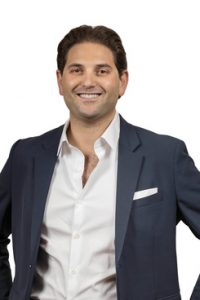South Florida retailers and restaurants weathered the pandemic better than most. Most found ways to adapt, but some closed for good. Those vacancies created opportunities for investors across the country to try to benefit from the influx of people and capital moving to the Sunshine State.
After the real estate market for restaurants and retail froze in the first and second quarters of 2020, deal work resumed in the third.
 PEBB Enterprises senior vice president of leasing Chris Stewart. Courtesy photo
PEBB Enterprises senior vice president of leasing Chris Stewart. Courtesy photo Chris Stewart, senior vice president of leasing PEBB Enterprises, a Boca Raton-based private equity real estate investment firm, said he's been closing on deals in the pipeline since last fall.
Recommended For You
"We signed five leases in the last two weeks, which is not really normal to sign that many deals in two weeks," Stewart said. "A retail lease can take three to 12 months, depending on who you're negotiating with. It's a good sign deals were being worked on in the middle of the pandemic."
Gyms and group fitness chains are moving back into spaces they vacated when the pandemic hit. On Lincoln Road, parking garages played host to fitness boot camps and yoga classes. Spas and salons are signing leases again. Bowling alleys and trampoline parks are eyeing vacant anchor properties in strip malls. Medical service providers, such as dental offices and urgent care clinics, are gobbling up dry retail spaces to service a growing and aging population.
The growth is coming from outside of the state, too. Restauranteurs from the Northeast to Chicago and California have moved in on second-generation restaurant space to pick up where original operators left off.
"You typically don't see those spaces shake loose over five to 10-year periods," said Colliers executive managing director of retail services Dave Preston. "The majority of activity through the end of last year into this year was restaurants looking for second-gen spaces, but now we're seeing more raw projects."
In other words, the market is healing.
But everyone involved — investors, developers, landlords and tenants — has to place a crucial bet over the next year: Will recent changes to consumer preference, such as curbside pick-up, food delivery, outdoor dining and walkable, outdoor spaces continue beyond the pandemic?
Here's what seven South Florida real estate developers and leasing agents are noticing. One thing they all agree on: This is the place to be in 2021.
Premium outdoor seating
Whereas a patio might have been a slight value-add pre-COVID-19, outdoor seating is in high demand nowadays. Some may be learning from cautionary tales — Stewart of PEBB Enterprises said the only tenants his company lost during the pandemic were sit-down, buffet-style restaurants.
Preston said he's seen more convertible restaurant spaces with NanaWalls, window-door combinations that can swing open for patio seating in the winter months and close for an air-conditioned environment in the summer.
And James Ginopoulos, retail and restaurant division leader at Origin Construction, said he's seen landlords increasingly willing to work with tenants to create more outdoor space.
"In one Boca Raton property, they cut the roadway in half, restricted car traffic, and that allowed them to build canopies and tents over the roadway so they could increase their seating capacity," Ginopoulos said in an interview. "From a design standpoint, that's the next step."
Continued on-street dining
 The Comras Company President and CEO Michael Comras. Courtesy photo.
The Comras Company President and CEO Michael Comras. Courtesy photo. Developers are split on the future of on-street dining, although most agree that some of the streets and parking spots ceded to restaurants will remain going forward.
"I think what we're starting to see is the growth of outdoor seating helping to pedestrianize South Florida," said Michael Comras of The Comras Co., a Miami Beach-based commercial real estate agency. "Some of this stuff will come back and get tracked down because a lot of things aren't necessarily up to code. A lot of stuff is being slid by that otherwise wouldn't be permitted in a normal time."
Stewart said he thinks municipalities will mostly reclaim parking spaces from on-street dining, but that diners' growing use of rideshare is diminishing the need for parking outside restaurants.
More drive-thru and curbside pick-up
Traditional quick-service restaurants that were previously content with limited outdoor seating and no drive-thru are looking to add drive-thrus and protected curbside parking spots, Stewart said.
"Tenants are asking us for those protected areas and we're more than happy to provide them, but when everybody asks for them, it creates a little bit of a challenge to accommodate everyone," he said.
 Tricera Capital co-founder and managing principal Scott Sherman. Courtesy photo
Tricera Capital co-founder and managing principal Scott Sherman. Courtesy photo According to Scott Sherman of the Miami-based real estate investment firm Tricera Capital, chains like Chipotle and Shake Shack that weren't as focused on drive-thru are seeking out those spaces, whereas chains with some drive-thru — like Starbucks and Panera — are looking to add more.
In South Florida's suburban areas, demand for drive-thru is putting a 30% to 40% premium on properties that can accommodate them, said Broward County commercial real estate leasing agent Beth Azor of Azor Advisory Services.
Restaurants are also looking to accommodate their growing delivery businesses, thanks to consumer preference shifting to services like Grubhub and UberEats during the pandemic, according to Ginopoulos.
"Landlords are now altering roadways around the back of the house, putting a drive-thru on the backside of the restaurant specifically devoted for delivery services," Ginopoulos said.
New names in town
Whether they're looking for more outdoor space, a growing market or lower taxes, national operators have multiple incentives to relocate to South Florida.
 Beth Azor, founder and principal of Azor Advisory Services. Courtesy Photo
Beth Azor, founder and principal of Azor Advisory Services. Courtesy Photo Azor said she had a three-year vacancy after Michaels left a 21,000 square foot anchor space.
"I had a gym from California that just signed that lease and they're opening in a couple of weeks," she said. "I have never, in my 34 years of doing this, signed a lease from someone who moved out here from California. They just bought a big house in Weston."
Larger, national tenants who haven't expanded to South Florida are looking at the region with cautious optimism, said Lyle Stern, president of the retail leasing and consulting firm Koniver Stern Group.
"The soft good tenants we represent are cautiously looking at which markets have tended to do better," Stern said. "At a moment in time, New York, Chicago, and Los Angeles were all closed. None of us are willing to bet against them, but we're seeing which parts of the market open sooner."
And some enterprising landlords, Stern said, will make short-term deals with tenants looking to dip their feet in water with pop-up locations.
"We're adjusting the rent structure to bring in new operators and keep venues unique," Stern said. "Local and national operators who couldn't afford the market before or couldn't find the right space can test the market for six months to two years and not have to make a long-term lease commitment."
Mixed-use spaces on the rise
Comras, whose company recently redesigned Coconut Grove's CocoWalk, said "work and play" spaces are in-demand in South Florida.
"The whole idea of the Grove is to make everyone's life simpler to live in that neighborhood. You drop off your kids at school, go to breakfast, get a haircut — you do everything without having to move," he said. "Miami has become a city of villages. All villages grow and expand and become more interconnected."
He cited Edgewater, Wynwood, the Design District and Performing Arts District as areas becoming increasingly more walkable.
Death of the anchor tenant?
Large anchor tenant spaces, typically reserved for department stores, are being written out of future design projects.
"Nowadays, people look at clusters of retailers like Apple and a collection of boutique brands as anchors," Comras said. "The traditional statement of a department store as an anchor is changing; the nature of department stores and how they're operating is changing."
Not that the pandemic sparked that phenomenon. In suburban Broward, the success of anchor tenants will depend more on their location and how well they've adapted to e-commerce.
"Anchor tenants were hard to lease pre-COVID," said Azor, the real estate leasing agent. "If Steinmart goes out of business in Aventura, I have 10 people who want in. My Michaels was in Plantation — not a top-five market. And if you have an empty anchor tenant in Margate or Tamarac, you're going to have an empty anchor tenant for a long time."
Related story: What Florida's Retail and Industrial Sectors Learned From the COVID-19 Pandemic
Demand (almost) everywhere
Margate and Tamarac, Azor said, are examples of the few losing areas in South Florida.
"Those that are overbuilt and are in a demographic shift are going to struggle," Azor said. "In Tamarac and Margate, it was an older population that's dying off. Now it's more of a lower-income area. When you've built 40 shopping centers in five miles and they all have 50% to 75% occupancy, that's not a winning formula."
Those markets will have to "decide what they want to be," Azor said, before tenants will want to move in. Until then, rents are likely to continue falling.
 Dave Preston executive managing director – retail services of Colliers International.
Dave Preston executive managing director – retail services of Colliers International. Most other suburban markets are seeing the same boom as urban areas, with no shortage of potential tenants in downtown Miami, Brickell, Wynwood, Miami Beach, Fort Lauderdale and Palm Beach, said multiple suburban and downtown developers.
And the foreseen shrinkage of commercial real estate elsewhere in the country is unlikely to affect the South Florida restaurants and retailers that rely on those populations showing up to work, Preston said, because a dearth of Northeastern companies — particularly in finance — is ready to snap up vacancies that arise.
Suburban areas are also feeling the boom, with Stewart seeing shopping centers 100% leased. "We haven't been 100% leased in five years, and we're also seeing new developments coming out of the ground," Preston said. "We're seeing no slowdown in demand for retail space. The pandemic hasn't shifted retailers' minds on opening new brick and mortar at all."
Long-term rent increases uncertain
"I think we're going to see a huge shift with the new population that's coming to our market," Azor said. "I hope in July, when it's 100 degrees and 100% humidity, that they stay."
If recent transplants become permanent residents, that could shift leasing rates up "10% in like a minute," she said.
"What happens is it never goes down from that in these high-demand, low vacancy markets," she said. "All of us are in this position, going into July to September, thinking, 'What's going to happen?' Because if they stay, it will change our retail world in South Florida forever."
© Touchpoint Markets, All Rights Reserved. Request academic re-use from www.copyright.com. All other uses, submit a request to [email protected]. For more inforrmation visit Asset & Logo Licensing.






